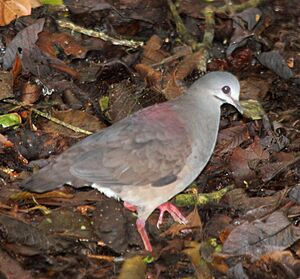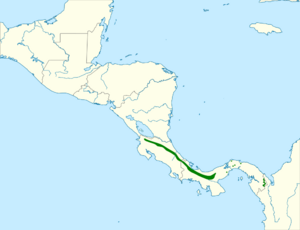Purplish-backed quail-dove facts for kids
Quick facts for kids Purplish-backed quail-dove |
|
|---|---|
 |
|
| Conservation status | |
| Scientific classification | |
| Genus: |
Zentrygon
|
| Species: |
lawrencii
|
 |
|
| Synonyms | |
|
|
The purplish-backed quail-dove (Zentrygon lawrencii) is a type of bird that belongs to the Columbidae family, which includes doves and pigeons. You can find this bird in Costa Rica and Panama.
Contents
About the Purplish-Backed Quail-Dove
Bird Family and History
The purplish-backed quail-dove is considered monotypic. This means it is the only member of its specific group, or "species," within its genus. Long ago, some people thought a group of these birds in northwestern Costa Rica was a different kind, like a subspecies. Also, this bird and the Tuxtla quail-dove from Mexico were once thought to be the same species.
What Does It Look Like?
Male purplish-backed quail-doves are about 26 to 27 centimeters (10 to 11 inches) long. Females are a bit smaller, around 25 centimeters (9.8 inches) long. They weigh about 220 grams (7.8 ounces).
Adult birds have a grayish-white forehead. Their head, neck, and the back of their neck are a bluish to greenish-gray color. The feathers on their back are a dull purple. The rest of their upper body and wings are olive-brown to blackish-brown, sometimes with a touch of red. Their central tail feathers are purple-brown, and the outer ones are blackish with gray tips.
Their face and throat are white. They have a black line near their malar area and another line from their beak to their eye. Their neck and chest are slate gray, with greenish sides. The center of their belly is a light tan to cinnamon color, and their sides are chocolate brown. Their eyes are brownish-orange to red, surrounded by bare, bright pink skin. Their legs and feet are also bright pink.
Young purplish-backed quail-doves look a little different. They don't have the green and purple colors on their back. Their face patterns are not as clear, and most of their feathers have light tan edges.
Where Does It Live?
The purplish-backed quail-dove lives in the Cordillera de Guanacaste mountains in northern Costa Rica. From there, it spreads southeast into central Panama. You can also find smaller groups of these birds in Darién Province.
This bird likes cool, wet, and thick montane forests. These are forests found in mountainous areas. On the Caribbean side of the mountains, they live at elevations from 400 to 800 meters (1,300 to 2,600 feet) high. In other areas, they can live as high as 2,600 meters (8,500 feet).
Behavior
How It Moves
The purplish-backed quail-dove usually prefers to walk or run away when it senses danger. It doesn't fly often, but sometimes it will fly to a higher branch or perch.
What It Eats
This bird looks for food on the ground. It usually forages alone or in pairs. Its diet includes fruit, seeds, insects, and worms.
Reproduction and Life Cycle
The breeding season for the purplish-backed quail-dove in Costa Rica is from June to October. In Panama, it seems to start earlier. The bird builds a nest that looks big but is loosely put together. It's shaped like a shallow bowl made of sticks, with softer materials inside. They place their nests in thick plants close to the ground. Females usually lay only one egg.
What Does It Sound Like?
The song of the purplish-backed quail-dove has three parts. It sounds like "pum-wha-huUUu." The last part of the song is the loudest and most important. When you hear it from far away, you usually only hear that last "huUUu" sound.
Status
The IUCN (International Union for Conservation of Nature) has looked at the purplish-backed quail-dove. They have listed it as a species of "Least Concern." This means it's not currently in danger of disappearing. Even though it seems fairly common, its future could be at risk if its forest home continues to be destroyed at the current speed.


